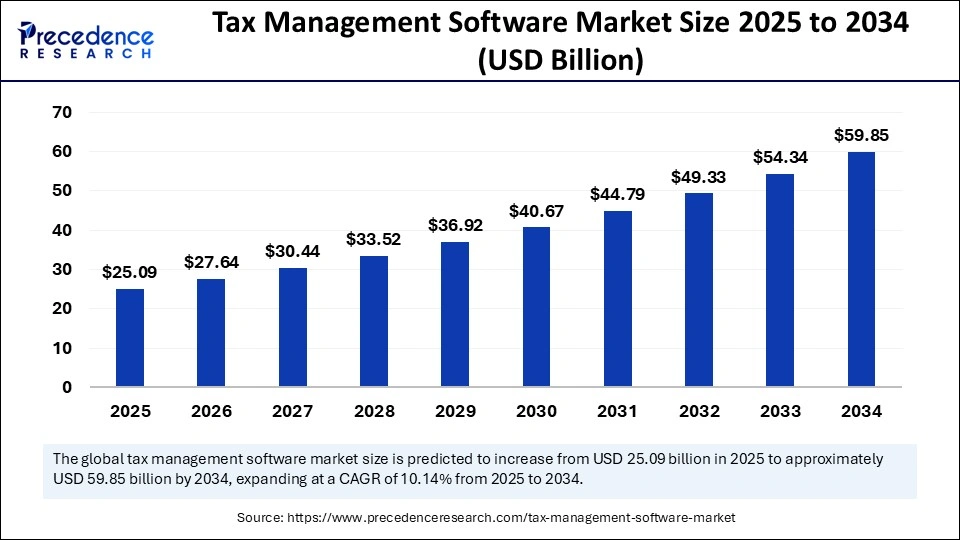
Tax Management Software Market Key Takeaways
- North America dominated the market with the largest share around 29% in 2024.
- Asia Pacific is expected to expand at the fastest CAGR during the forecast period.
- By component, the software segment dominated the market with the highest share of 73% in 2024.
- By component, the professional services segment is expected to witness significant growth during the projected timeframe.
- By type, the tax compliance software segment captured the biggest market share of 27% in 2024.
- By type, the tax prepared software segment is expected to grow at the fastest CAGR during the forecast period.
- By tax type, the direct tax segment led the market with the largest share of 54% in 2024.
- By tax type, the indirect tax segment is projected to grow at the fastest CAGR during the projection period.
- By deployment, the on-premises segment held the largest market share of 52% in 2024.
- By deployment, the cloud segment is expected to grow at the fastest CAGR in the coming years.
- By organization size, the large enterprises segment dominated the market in 2024.
- By organization size, the small & medium enterprises segment is expected to grow at the fastest CAGR in the upcoming period.
- By industry vertical, the BFSI segment dominated the market with the largest share in 2024.
- By industry vertical, the retail segment is expected to grow at the fastest CAGR between 2025 and 2034.
Market Overview
The tax management software market has grown significantly in recent years, driven by the increasing complexity of global tax regulations and the rapid digitalization of financial operations. This market includes solutions that automate tax calculations, filing, reporting, and compliance management across various industries and business sizes. As companies strive for accuracy and efficiency in tax reporting, tax management software is becoming an essential component of financial technology ecosystems. Cloud-based platforms and AI-enhanced solutions are setting new benchmarks for how businesses manage compliance and mitigate risk.
Drivers
One of the primary drivers of the tax management software market is the tightening of government regulations and the move toward real-time tax reporting in many countries. Businesses are compelled to adopt reliable software tools to avoid non-compliance penalties and audit risks. The integration of tax software with ERP systems, accounting platforms, and e-invoicing tools further enhances operational efficiency. The need for transparency and the push toward digital tax authorities are also encouraging adoption among enterprises and SMEs alike.
Opportunities
There is a significant opportunity in the expansion of tax management software into emerging markets where governments are increasingly enforcing tax digitization initiatives. Industry-specific solutions tailored for sectors like e-commerce, manufacturing, and financial services are also gaining traction. With the rise of cross-border commerce and remote working models, demand is surging for software that can handle multi-jurisdictional compliance and transfer pricing. Integration with AI and machine learning offers the potential for predictive analytics, fraud detection, and process automation in tax operations.
Challenges
Despite its advantages, the tax management software market faces several challenges, including the need for continuous updates to keep pace with rapidly changing tax laws. Small and mid-sized businesses often find the initial cost of implementation and customization a barrier. Moreover, data privacy concerns and cybersecurity threats are growing due to the sensitive nature of tax information stored and transmitted via cloud-based systems. The lack of skilled professionals who can manage and interpret automated tax solutions is another constraint in maximizing software utility.
Regional Insights
North America leads the tax management software market, supported by advanced digital infrastructure and a complex tax landscape that necessitates automation. Europe follows closely, especially in regions enforcing real-time VAT reporting. The Asia-Pacific region is showing robust growth, with countries like India, China, and Australia implementing digital tax reforms and e-filing mandates. Latin America and the Middle East are beginning to embrace tax digitization, driven by regulatory pressures and the need for greater transparency in tax collection.
Recent Developments
Recent developments in the market include the introduction of cloud-native tax management platforms that offer greater scalability and integration flexibility. Leading vendors are investing in AI-driven tax engines and natural language processing features to improve user experience. Strategic partnerships between tax software providers and global ERP vendors are enhancing product functionality and global reach. Regulatory changes, such as the global minimum corporate tax framework, are also prompting updates to software capabilities to ensure ongoing compliance.
Tax Management Software Market Companies
- Wolters Kluwer N.V
- SAP SE
- Thomson Reuters
- Intuit, Inc.
- Corvee, LLC
- HRB Digital LLC
- TaxJar
- Vertex, Inc.
- TaxSlayer LLC
- Avalara, Inc.
Segments Covered in the Report
By Component
- Software
- Professional Services
By Type
- Corporate Tax Software
- Professional Tax Software
- Tax Preparer Software
- Tax Compliance Software
- Others
By Tax Type
- Indirect Tax
- Direct Tax
By Deployment
- Cloud
- On-premises
- By Organization Size
- Large Enterprises
- Small & Medium Enterprises
By Industry Vertical
- BFSI
- Healthcare
- Retail
- Manufacturing
- Real Estate
- Others
By Region
- North America
- Europe
- Asia Pacific
- Latin America
- Middle East & Africa